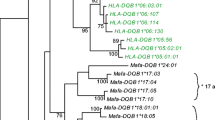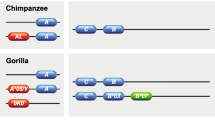Abstract
The sequence-based map of a part of the rhesus macaque major histocompatibility complex (MHC) extended class II region is presented. The sequenced region encompasses 67,401 bp and contains the SACM2L, RING1, FABGL and KE4 genes, as well as the HTATSF1-like and ZNF-like pseudogenes. Similar to human, but different from rat and mouse, no class I genes are found in the SACM2L-RING1 interval. The rhesus macaque extended MHC class II region shows a high degree of conservation of exonic as well as intronic and intergenic sequences compared with the respective human region. It is concluded that this particular genomic organization of the extended class II region—i.e., the absence of class I genes and the presence of the HTATSF1-like and ZNF-like pseudogenes—can be traced back to a common ancestor of humans and rhesus macaques about 23 million years ago.




Similar content being viewed by others
References
Doherty PC, Zinkernagel R (1975) Enhanced immunologic surveillance in mice heterozygous at the H-2 gene complex. Nature 256:50–52
Felsenstein J (1985) Confidence limits on phylogenies: an approach using the bootstrap. Evolution 39:783–791
Flajnik MF, Kasahara M (2001) Comparative genomics of the MHC: glimpses into the evolution of the adaptive immune system. Immunity 15:351–362
Flajnik MF, Ohta Y, Namikawa-Yamada C, Nonaka M (1999) Insight into the primordial MHC from studies in ectothermic vertebrates. Immunol Rev 167:59–67
Hanson IM, Trowsdale J (1991) Colinearity of novel genes in the class II regions of the MHC in mouse and human. Immunogenetics 34:5–11
Herberg JA, Beck S, Trowsdale J (1998) TAPASIN, DAXX, RGL2, HKE2 and four new genes (BING 1, 3 to 5) form a dense cluster at the centromeric end of the MHC. J Mol Biol 277:839–857
Hughes AL (1999) Balancing selection: the major histocompatibility complex. In: Hughes AL (ed) Adaptive evolution of genes and genomes. Oxford University Press, New York, pp 54–89
Hughes AL, Nei M (1988) Pattern of nucleotide substitution at major histocompatibility complex class I loci reveals overdominant selection. Nature 335:167–170
Hughes AL, Nei M (1989) Nucleotide substitution at major histocompatibility complex class II loci: evidence for overdominant selection. Proc Natl Acad Sci USA 86:958–962
Kimura M (1980) A simple method for estimating evolutionary rate of base substitutions through comparative studies of nucleotide sequences. J Mol Evol 16:111–120
Kumar S, Gadagkar SR (2001) Disparity index: a simple statistic to measure and test the homogeneity of substitution patterns between molecular sequences. Genetics 158:1321–1327
Kumar S, Hedges SB (1998) A molecular timescale for vertebrate evolution. Nature 392:917–920
Kumar S, Subramanian S (2002) Mutation rates in mammalian genomes. Proc Natl Acad Sci USA 99:803–808
Kumar S, Tamura K, Jakobsen IB, Nei M (2001) MEGA2: molecular evolutionary genetics analysis software. Arizona State University, Tempe, Ariz.
Martin AF, Allcock R, Price P (2000) The murine major histocompatibility complex. Immunol Today 21, No 7, centerfold between pp 332–333
Martin RD (1993) Primate origins: plugging the gaps. Nature 363:223–234
Smit AFA (1999) Interspersed repeats and other mementos of transposable elements in mammalian genomes. Curr Opin Genet Dev 9:657–663
Sonnhammer ELL, Durbin R (1996) A dot-matrix program with dynamic threshold control suited for genomic DNA and protein sequence analysis. Gene 167:G1–10
Stephens R, Horton R, Humphray S, Rowen L, Trowsdale J, Beck S (1999) Gene organisation, sequence variation and isochore structure at the centromeric boundary of the human MHC. J Mol Biol 291:789–799
The MHC Sequencing Consortium (1999) Complete sequence and gene map of a human major histocompatibility complex. Nature 401:921–923
Walter L, Günther E (1998) Identification of a novel highly conserved gene in the centromeric part of the major histocompatibility complex. Genomics 52:298–304
Walter L, Günther E (2000) Physical mapping and evolution of the centromeric class I gene-containing region of the rat MHC. Immunogenetics 51:829–837
Walter L, Fischer K, Günther E (1996) Physical mapping of the Ring1, Ring2, Ke6, Ke4, Rxrb, Col11a2, and RT1.Hb genes in the rat major histocompatibility complex. Immunogenetics 44:218–221
Acknowledgements
The rhesus macaque sequencing was supported by the German National Genome Research Network (NGFN) and the Max-Planck-Society.
Author information
Authors and Affiliations
Corresponding author
Additional information
The nucleotide sequence reported here has been assigned the database accession number AJ421778
Rights and permissions
About this article
Cite this article
Sudbrak, R., Reinhardt, R., Hennig, S. et al. Comparative and evolutionary analysis of the rhesus macaque extended MHC class II region. Immunogenetics 54, 699–704 (2003). https://doi.org/10.1007/s00251-002-0515-z
Received:
Revised:
Published:
Issue Date:
DOI: https://doi.org/10.1007/s00251-002-0515-z




